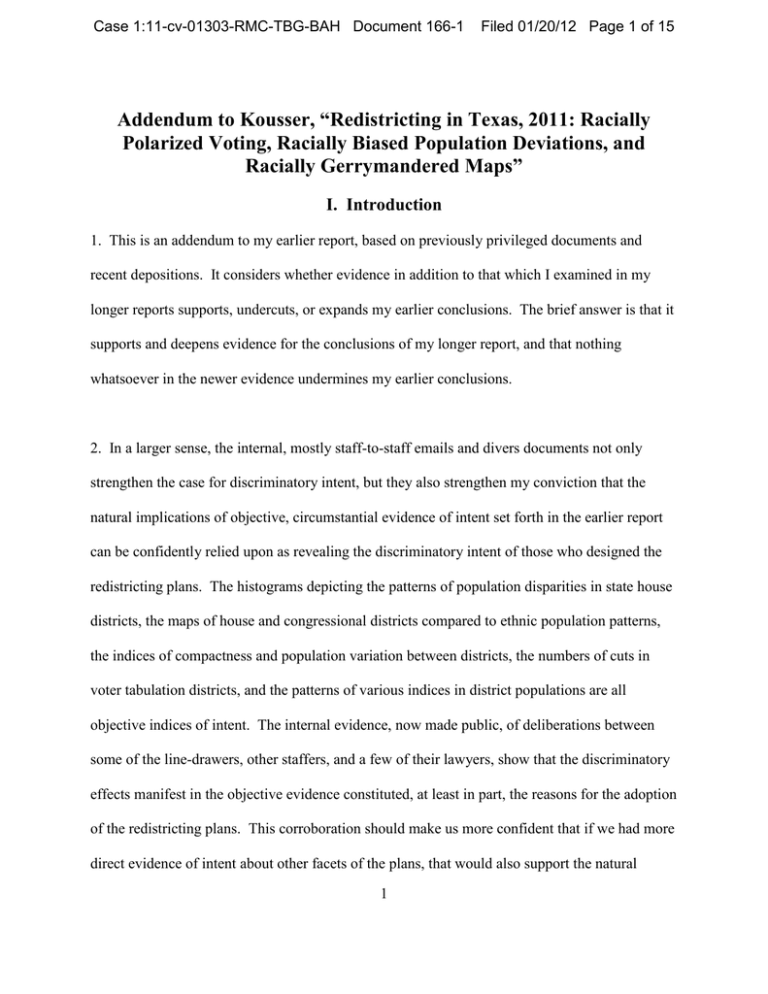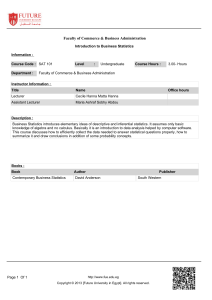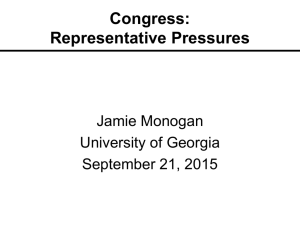Addendum to Kousser, “Redistricting in Texas, 2011: Racially
advertisement

Case 1:11-cv-01303-RMC-TBG-BAH Document 166-1 Filed 01/20/12 Page 1 of 15 Addendum to Kousser, “Redistricting in Texas, 2011: Racially Polarized Voting, Racially Biased Population Deviations, and Racially Gerrymandered Maps” I. Introduction 1. This is an addendum to my earlier report, based on previously privileged documents and recent depositions. It considers whether evidence in addition to that which I examined in my longer reports supports, undercuts, or expands my earlier conclusions. The brief answer is that it supports and deepens evidence for the conclusions of my longer report, and that nothing whatsoever in the newer evidence undermines my earlier conclusions. 2. In a larger sense, the internal, mostly staff-to-staff emails and divers documents not only strengthen the case for discriminatory intent, but they also strengthen my conviction that the natural implications of objective, circumstantial evidence of intent set forth in the earlier report can be confidently relied upon as revealing the discriminatory intent of those who designed the redistricting plans. The histograms depicting the patterns of population disparities in state house districts, the maps of house and congressional districts compared to ethnic population patterns, the indices of compactness and population variation between districts, the numbers of cuts in voter tabulation districts, and the patterns of various indices in district populations are all objective indices of intent. The internal evidence, now made public, of deliberations between some of the line-drawers, other staffers, and a few of their lawyers, show that the discriminatory effects manifest in the objective evidence constituted, at least in part, the reasons for the adoption of the redistricting plans. This corroboration should make us more confident that if we had more direct evidence of intent about other facets of the plans, that would also support the natural 1 Case 1:11-cv-01303-RMC-TBG-BAH Document 166-1 Filed 01/20/12 Page 2 of 15 inferences from the objective, public evidence. 3. The new, internal evidence also casts additional light on the previous public qualitative evidence, such as statements made by proponents of the plans in legislative debates. In particular, it shows that the redistricting authorities were much more skeptical of their plans‟ legality under the Voting Rights Act and much less convinced that majority-HCVAP or -SSVR districts would satisfy Section 5 than they stated publicly. They knew that there was a very strong risk that their plans were likely to be denied preclearance, but they went ahead anyway. This supports the conclusion that they adopted discriminatory plans not in spite of their discriminatory consequences, but because they desired those consequences. 4. In what follows, I will quote and paraphrase the new evidence, organizing it under a series of topics that are related to the questions of discriminatory intent.. II. Majority-HCVAP and “Performing” Districts 5. The public record makes it clear that the State did not rely wholly on a majority-minority bright line to define districts that might satisfy the non-retrogressive effect standard of Section 5, for they counted districts that were less than or slightly over 40 percent African-American in both the baseline and final statistics. What the private evidence makes clear is 1) that they painstakingly manipulated district lines to construct districts that were above an ethnic 2 Case 1:11-cv-01303-RMC-TBG-BAH Document 166-1 Filed 01/20/12 Page 3 of 15 percentage threshold, but were below a carefully-estimated threshold of electability; 2) that they wavered on what ethnic percentage threshold courts were likely to adopt, and tried to manipulate thresholds to insure that the ones most favorable to their plans were the ones used; and 3) that they knew that both the intent and effect prongs of Section 5 might be judged by the ability of minorities to elect candidates of choice, not just whether a district was slightly on one or the other sign of a politically-artificial line. 6. One of the most interesting emails is from Eric Opiela to Gerardo Interiano on Nov. 17, 2010, six-and-a-half months before the congressional plan was made public, that detailed exactly how – and how early – the line-drawers planned to raise the ethnic threshold, but decrease the actual ability to elect a Latino candidate of choice in the crucial 23rd congressional district.1 . . . it would be really useful [Opiela remarked] for someone to go in and calculate a ratio for every census block in the state of CVAP/Total Population, a ratio of Hispanic CVAP/Total Hispanic Population, a ratio of Spanish Surname RV [registered voters]/Hispanic CVAP, and a ratio of Spanish Surname RV/Total Hispanic Population . . . . It also would be good to calculate a Spanish Surname Turnout/Total Turnout ratio for the 2006-2010 General Elections for all VTDs [voter tabulation districts]. (I already have the data for this for 2006-2008 in a spreadsheet, just need to gather it for every VTD for 2010.) These metrics would be useful in identifying a “nudge factor” by which one can analyze which census blocks, when added to a particular district (especially 50+1 minority majority districts) help pull the district‟s Total Hispanic Pop[ulation] and Hispanic CVAPs up to majority status,but leave the Spanish Surname RV and TO [turnout] to the lowest. This is especially valuable in shoring up Canseco and Farenthold. 1 The fact that they did so was not only noted in Ryan Downton‟s deposition in Perez v. Perry, at 96, but also in comments on the House floor by Republican Rep. Harvey Hildebrand. See my longer report on this case, at 104, n.93. 3 Case 1:11-cv-01303-RMC-TBG-BAH Document 166-1 Filed 01/20/12 Page 4 of 15 After Interiano promised to help, Opiela replied that he should think of this as “OHRVS” [:] Optimal Hispanic Republican Voting Strength . . .[his elision] a measure of how Hispanic, and Republican at the same time we can make a particular census block.”2 7. This is more than using the wrong threshold. It is private evidence that mirrors the circumstantial public evidence that those who drew the districts manipulated the ethnic threshold that they would later insist was the proper measure of non-retrogression in order to diminish the opportunity of Latinos to elect their candidate of choice. 8. Ryan Downton, who was drawing congressional districts, later apparently used Opiela‟s census block figures to manipulate the boundaries of congressional district 23, and his email to Doug Davis and Gerardo Interiano, shows that the concern to manipulate the ethnic percentages and the “performance” statistics continued throughout the period of designing districts. By that time, the Attorney General‟s office had chosen ten statewide elections as indicative of whether a district “performed” for Latinos.3 The Texas Legislative Council (TLC) could and did easily 2 Interiano deposition, Jan. 10, 2012, exhibit 8. Bracketed information added for clarity. Interiano followed up Opiela‟s request with Clare Dyer, manager of the Mapping and Redistricting Section, Research Division, TLC. See Dyer to Interiano, Dec. 9, 2010, at LP0000487 [Bates number for Legislative Privilege Documents]. 3 David Hanna deposition, Jan. 12, 2012, at 30, on the authorship of the index. 4 Case 1:11-cv-01303-RMC-TBG-BAH Document 166-1 Filed 01/20/12 Page 5 of 15 turn out reports that calculated how many of those elections Latino-preferred candidates won in the precincts covered by any plan. Commenting on the 23rd congressional district, Downton told Interiano and Davis: “Have it over 59% HCVAP, but still at 1/10 [i.e., Latino-preferred candidates won only one out of ten elections in the new boundaries]. There has to be some level of HCVAP where it doesn‟t make any difference what the election results are.”4 9. The simultaneous use of two indices – the artificial HCVAP and SSRV scores and the politically-relevant Attorney-General‟s Latino Performance Index – and the documented effort to maximize the first in order to minimize the second is evidence of a discriminatory intent. 10. At one point, the redistricters went so far as to tout as a “coalition district” congressional district 6, the suburban and exurban, safely Republican district that thrust a tentacle north through Latino areas of Tarrant and Dallas Counties, as a pro-minority facet of the plan. In an email to Interiano entitled “Congressional Talking Points,” apparently meant to brief either Redistricting Committee Chair Burt Solomons or Speaker Joe Strauss, Downton suggested that to counter Rep. Marc Veasey‟s criticism of the failure to draw a minority opportunity congressional district in the Metroplex, Solomons should point out that H283 drew “a coalition district in District 6, with a combined Hispanic voting age population (39.6%) and Black voting 4 Downton to Interiano and Davis, May 28, 2011, at LP0000192. State Sen. Kel Seliger told a June 3 Senate hearing that Davis and Interiano drew the congressional plan (LP00035657), but Downton obviously assisted. 5 Case 1:11-cv-01303-RMC-TBG-BAH Document 166-1 Filed 01/20/12 Page 6 of 15 age population (12.3%) exceeding 50%.”5 11. When a constituent asked state Sen. Steve Ogden whether “the minority percentages that are considered in redistricting [are] based on all minorities present or US citizen minorities only?”, Ogden‟s chief of staff emailed Doug Davis for an answer. Davis replied: “Well, both. There‟s no one matrix that gets you over the hump under the Voting Rights Act. It‟s a blend of percentages, election data, and citizenship. All run through a regression analysis by statisticians to assess the ability of minority voters to elect their candidate of choice.”6 Speaking of Downton, Interiano, and himself, David Hanna of the TLC commented in his deposition that “I think that we all struggled with trying to figure out what the proper measure was. And we knew that there was an election analysis component to it and at least from the 2001 objection letter, it suggested that perhaps there‟s a demographic component to it.”7 Jeffrey Archer, Hanna‟s colleague at the TLC, agreed in his deposition with a question that said that “performance, and election performance specifically, is a metric that needs to be looked [at] in determining” compliance with Sections 2 and 5. He did not rely entirely on HCVAP or SSRV.8 5 Downton to Interiano, June 13, 2011, LP0001481-84. See Figures 11a and 11b and Table 23 in my larger report. 6 Davis to Constance Allison, June 2, 2011, at LP0001826. 7 David Hanna Deposition, Jan. 12, 2012, at 111. 8 Jeffrey Archer Deposition, Jan. 12, 2012, at 14, 33. 6 Case 1:11-cv-01303-RMC-TBG-BAH Document 166-1 Filed 01/20/12 Page 7 of 15 12. In view of the State‟s inconsistency in using indices to gauge non-retrogression and its blatant attempt to manipulate districts to “nudge” across thresholds that redistricters did not believe bore any relation to political outcomes, its current insistence on a bright-line 50% HCVAP standard ought itself to be considered indicative of a discriminatory purpose. III. Disregarding Warnings That Districts Were Illegal 13. The public record is replete with charges by minority advocacy groups and newspaper editorial boards that H283 and C185 discriminated against African-Americans, Asian Americans, and Latinos and warnings that the proposed districts would not be precleared.. The private record reveals that Republicans and redistricting lawyers offered similar warnings. 14. Perhaps the most dramatic was this one from Dub Maines, a member of Congressman Joe Barton‟s staff, which Gerardo Interiano passed along to TLC Senior Legislative Counsel David Hanna: I would really appreciate you looking at this modified Solomons/Seliger map. It is 26R and 10D, as is the one the House Committee just passed. However, the Committee-passed map badly retrogressed CD20 without creating a new VRA dist. CD35 is in no way a VRA district; it is a district that re-elects Congressman Doggett whether he receives the support of Hispanic voters or not. In the map I‟ve sent you, CD25 is a heavily-Republican, Hill Country, West Texas district. CD20, contains the southeast quadrant of Travis County, has incumbent Congrssman Charlie Gonzales in it, is heavily Bexar County, and is a legal, performing VRA dist. CD35 is an open seat and is a district from southern and central Bexar County 7 Case 1:11-cv-01303-RMC-TBG-BAH Document 166-1 Filed 01/20/12 Page 8 of 15 to Webb County. It is a legal, performing VRA district. The Committee map, as passed, has next to no chance of pre-clearance - either by Justice or the DC circuit court. The map I‟ve sent you has a very high probability of preclearing - at least in the DC court. This is the analysis of those who have practiced in the Voting Rights area - very successfully - for over 25 years. I would encourage you to speak with them about the Committee-passed map. They may be from evil DC, but they ARE the premier experts in this area, and I believe it wd be prudent to entertain their thoughts on this map! There seems to be quite a bit of confusion about Section 5 pre-clearance. Section 5 is not like Section 2, in that Section 2 deals with existing maps and makes minimal changes to those existing maps, if the courts feel changes are needed. Section 5 preclearance decides if a map ever really „exists.‟ If a map is not pre-cleared, then it is as if nothing had ever been drawn. The courts will draw the map de novo as they did in 2001. Doggett will be re-elected. Canseco will not be. Farenthold will not be. They will likely split the baby on the 4 new seats. The Ds pick up a net of 4 seats. The Rs pick up a net of zero seats. This idea of challenging the Constitutionality of Section 5 is high-risk poker with no discernible positive return. Again, I would appreciate you importing and looking at this map. Please call on me if you have any questions, comments, or suggestions. Thank you, Dub Maines9 In a subsequent email, Interiano remarked that Maines‟s memo, which was apparently widely circulated, “has been the issue consuming all of my time this week.”10 15. More vaguely, David Hanna of the TLC warned that preclearance would “likely [be] an issue” in Nueces and later urged Denise Davis to “slow[] down the plan a bit” because “Your minority districts have some issues with Sec. 5.”11 To Interiano and Downton, he was both more 9 In Interiano to Hanna, June 9, 2011, at LP0001514-15. My italics. 10 Interiano to Denise Davis, with a copy to Lisa Kaufman, June 11, 2011, LP0001544. 11 Hanna to Davis, Feb. 17, and April 8, 2011, in Hanna email files, unpaginated. In his deposition, Hanna remarked that the legislature did nothing to resolve the issues he had raised 8 Case 1:11-cv-01303-RMC-TBG-BAH Document 166-1 Filed 01/20/12 Page 9 of 15 technical and more precise in his warnings. While everyone was using SSVR as a substitute for HCVAP before the American Community Survey‟s special tabulation became available, Hanna pointed out an ambiguity with SSVR: The TLC had loaded only “non-suspense SSVR” – which excluded registered voters who failed to respond to a confirmation of residence notice sent when county voter registrars have reason to believe that the voter has a different address – into its RedAppl system that legislators and others used in drawing districts. But “total registration” was larger, and if “SSVR total” was used as an index of the percentage of Latino registered voters in a district, then the MALDEF plan for the house would have seven more majority-Latino state house districts than the Committee plan, rather than the four more if “non-suspense SSVR” were used. More important for Section 5 purposes, the Committee plan, by the “SSVR total” index, would fall four districts short of the total for the 2001 baseline plan. Indicating his concern that the plan might not be precleared, Hanna doubted that all four of the plan‟s districts that were near-50% SSVR total could be raised above that artificial barrier.12 16. In his deposition, Hanna “didn‟t feel like my concerns” about congressional district 23, which he had expressed during the redistricting process, had been resolved, “even to this day.”13 with Davis in his April 8 email, those relating to house districts 40, 41, and 35. Hanna deposition 132-36. 12 Hanna deposition exhibit 7, Hanna to Interiano and Downton, April 21, 2011. At this point, the bill was already on the house floor. 13 Hanna deposition, at 70. 9 Case 1:11-cv-01303-RMC-TBG-BAH Document 166-1 Filed 01/20/12 Page 10 of 15 The changes in state house district 40, he indicated in more than one email, were similar to those in Cameron that had drawn an objection from the Justice Department in 2001.14 In another email, he indicated that he had meant “that these are some issues that I have seen that would mean it [H283] potentially wouldn‟t comply with the Voting Rights Act.”15 He also implied in his deposition that he had earlier indicated to Downton and Interiano skepticism about whether raising the Latino percentage in two already-performing districts, 90 and 148, would “enhance the chances of [the] State receiving preclearance in the plan.”16 Although Hanna believed it was possible to draw two Latino ability-to-elect districts in Nueces County by joining them with a bit of an adjacent county, Interiano rejected such an effort, which would have alleviated the retrogression problem, because it would have paired two Anglo Republicans.17 IV. The Legislative Process 17. Latino and African-American legislators charged again and again that the legislative process was biased against them. Evidence from the previously privileged files supports their charges and adds new ammunition to them. 14 Hanna Deposition, at 89-90, 100. 15 Hanna Deposition, at 103. 16 Hanna Deposition, at 110. 17 Hanna Deposition, at 142. 10 Case 1:11-cv-01303-RMC-TBG-BAH Document 166-1 Filed 01/20/12 Page 11 of 15 18. 120 pages of the legislative privilege files are taken up with nearly identical sheets, one for each Republican legislator. On each sheet is an outline of the house member‟s proposed new district, in the area of the state where they reside. Above the map is a statement: “As long as the statewide map in HB 150 includes the district depicted in this map, I will vote in favor of passage of HB 150.” Each has a place for the legislator‟s signature, and they all dutifully signed on.18 None of the sheets appears to contain a Democratic district or to be signed by a Democrat. Whether Democrats were shown their districts before the house plan was made public is unclear, though there are several public record statements, quoted in my longer report, that indicates that many, if not all Democrats, minority or Anglo, were shut out of the process altogether. In any event, it seems quite extraordinary for the redistricters to leave such a paper trail about the inclusion of one group (and, by implication, the exclusion of others) in the drawing of districts.19 19. In emails in the private files, the lawyers advising the redistricting authorities echoed public charges by minority legislators20 that the process was being rushed and the public was being 18 LP0001834-1953. 19 The legislative privilege file contains several memos from Interiano to Denise Davis and Lisa Kaufman of Speaker Straus‟s office listing members of the state house whom he believed would support the plan, indicating how closely they consulted with the Republican majority. LP0000557 (April 8, 2011), LP0000604 (April 21, 2011), LP0000688 (April 27, 2011). The plan passed on an almost straight party-line vote. 20 The redistricting files contain reports of the minority members‟ charges, indicating the 11 Case 1:11-cv-01303-RMC-TBG-BAH Document 166-1 Filed 01/20/12 Page 12 of 15 excluded from it. For instance, David Hanna emailed Bonnie Bruce, the chief of staff to Chairman Solomons, that the hearing schedule is a little too tight to receive meaningful input from people. The House will be in session Friday and this will interfere with members being able to come. I would wait longer and not have the hearing when the house is in session. . . . The process on this is important for both preclearance and litigation. People and members must be given a meaningful opportunity to comment on the plan you lay out. Since I don‟t think the senate will do much with it, the only opportunity for public input on the plan to be reflected with amendments is in the house committee phase.21 Four days later, Hanna emailed Denise Davis to oppose rushing the house redistricting bill to the floor as a possible violation of house rules and as something that would anger committee members, because only Chairman Solomons had seen the whole plan at that time.22 Obviously, the plan had not been presented, even to the committee, in time for a committee hearing. 20. The leadership ignored Hanna‟s pleas, and the last minute rush in getting the bill to the floor, as outlined by House Committee Coordinator Stacey Nicchio, was a travesty of the deliberative process: Republicans‟ concern with the allegations. E.g., LP0000356-57, LP0001224-25. They also contain a memo on transparency in congressional redistricting, dated June 17, 2010, published jointly by the Brookings Institution and the American Enterprise Institute. LP0000430-32, indicating the Texas House Redistricting Committee‟s concern with transparency. Texas followed almost none of the practices recommended by the Brookings/AEI memo. 21 David Hanna deposition, exhibit 5, Hanna to Davis, April 13, 2011. 22 Hanna to Davis, April 17, 2011, in Hanna email file, unpaginated. 12 Case 1:11-cv-01303-RMC-TBG-BAH Document 166-1 Filed 01/20/12 Page 13 of 15 It is my understanding that the Calendars comm will be meeting tonight at 9:00 p.m. to possibly consider HB 150. That committee report has not been turned in yet, because Bonnie is still waiting for hard copies of the bill text and the BA [bill analysis?]. David Hanna indicated to me that he thought they could deliver the bill text and BA around 6:30 or so. Bonnie [Bruce]is ready to go on the other items in the committee report packet, so as soon as she gets the BA and copies of the bill from TLC, she will be able to turn in the CR [committee report] to our office for a quick review and delivery to Doc Prod [document production]. Doc Prod will work their magic and get it to the Chief Clerk‟s office as soon as possible so that the Calendar clerk can pick it up before they meet on it.23 V. The Awareness of Population Equality Issues 21. That the redistricting authorities violated Larios v. Cox may prove only a discriminatory effect, a violation of Section 2 of the Voting Rights Act and the Fourteenth Amendment; but that they did so knowingly is evidence of a discriminatory intent, a potential violation of Section 5. The evidence in the privileged files further buttresses the conclusion that the violation of Larios was intentional. 22. In his deposition in Perez v. Perry, Ryan Downton, who had had no previous experience in redistricting, remarked that one of the documents he consulted was “whatever the National Conference of State Legislatures put out on redistricting.”24 That report is in the committee‟s 23 Stacey Nicchio to Bonnie Bruce, Jennifer Welch, Lisa Kaufman, Interiano, Chris Griesel, Damian Duarte, Kris Burrows, Janet Sullivan, David Hanna, April 19, 2011, 5:22 pm, LP0001492. 24 Quoted in my larger report, at 65, n. 39. 13 Case 1:11-cv-01303-RMC-TBG-BAH Document 166-1 Filed 01/20/12 Page 14 of 15 files, and it contains a substantial fourteen-page chapter on the equal population requirement for drawing state legislative plans, which includes the following: States should not assume that any legislative districting plan having less than a 10percent overall range is safe from successful challenge. Even if the Court is prepared to allow the states some leeway from redistricting perfection, now that the basic law of pop equality is well established, it is unlikely that the justices wd be unduly hesitant to strike down a plan having an overall rang of less than 10 percent if a challenger were to succeed in raising a suspicion that the plan was not a good faith effort overall or that there was something suspect about the districts involved.25 The files also contain a copy of the Stateline article, “„One person, one vote‟ still an unsettled question for states,” which I cited in the body of my report as something generally available to legislators at the time of the 2011 redistricting. That article contained a capsule, very clear discussion of Larios.26 23. The files also contain six pages of Power Point slides from a presentation that David Hanna made to the House Redistricting Committee on March 1, 2011 entitled “The County Line Rule for House Districts.” Discussing such very specific issues as how particular counties in Texas might be combined to reach the ideal population for a district, Hanna discussed the leading Texas Supreme Court cases on the subject, Smith v. Craddick and Clements v. Valles, noting that they allowed districts to cross county lines “when required to comply with the one-person, one-vote 25 NCSL, “Redistricting Law 2010", at 36 of report, D00003445. The report had an excellent discussion of case law since Larios. 26 The Stateline article, cited and quoted in my larger report at 65, is in the files at D00003661-63. 14 Case 1:11-cv-01303-RMC-TBG-BAH Document 166-1 Filed 01/20/12 Page 15 of 15 requirement of the 14th Amendment to the US. Constitution; or the Voting Rights Act.” He went on to discuss Larios: “As applied to legislative districts the one-person, one-vote requirement allows for a 10% deviation without justification, though this has been called into question in Larios v. Cox.”27 24. Legislators and staffers were not only informed by the publication of the redistricting guide by the TLC, written largely by Hanna and Jeffrey Archer. They were alerted to the necessity to avoid discriminatory population disparities by oral and written presentations contained in the previously privileged files. Clearly, they had foreknowledge that their discriminatory actions in drawing districts that disproportionately disadvantaged Latinos. 27 D00004550-55. 15







